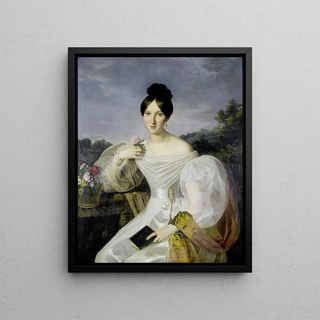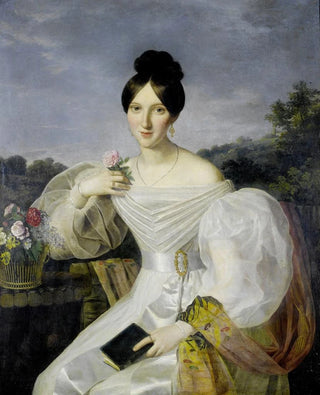Art print | Dame in white dress - Ferdinand Georg Waldmüller workshop


View from behind

Frame (optional)
In the vast panorama of art history, some artworks transcend time and space, captivating viewers' minds and evoking deep emotions. "L Dame en robe blanche - Atelier de Ferdinand Georg Waldmüller" falls into this privileged category. This painting, which evokes grace and delicacy, transports us to the heart of the 19th century, an era when art reflected an intensified sensitivity and a constant pursuit of beauty. The depiction of a woman dressed in an immaculate dress, standing with quiet confidence, embodies not only the aesthetic of her time but also an introspection on the role of women in society.
Style and uniqueness of the work
Waldmüller's work is characterized by striking realism that captures the nuances of light and the subtleties of human expressions. In "L Dame en robe blanche," the choice of white, a symbol of purity and elegance, highlights the sophistication of the subject while suggesting a certain fragility. The way light plays on the folds of the dress and illuminates the lady's face demonstrates unparalleled technical mastery. The meticulous details, such as reflections in the fabrics and the softness of the features, create an intimate atmosphere where the observer is invited to contemplate not only the outer appearance of the woman but also her inner world. This work stands out for its ability to combine a faithful representation with an almost poetic dimension, where each brushstroke seems to tell a story.
The artist and his influence
Ferdinand Georg Waldmüller, an emblematic figure of Austrian Romanticism, established himself as a master in portraiture and still life. His career, marked by success, was driven by a desire to capture the very essence of his subjects, whether human or natural. Waldmüller was a pioneer in the use of light and shadow techniques, influencing many artists who followed him. His innovative approach redefined portraiture, making it more accessible and emphasizing the psychology of the characters. Through "L Dame en robe blanche," he shows us

Matte finish

View from behind

Frame (optional)
In the vast panorama of art history, some artworks transcend time and space, captivating viewers' minds and evoking deep emotions. "L Dame en robe blanche - Atelier de Ferdinand Georg Waldmüller" falls into this privileged category. This painting, which evokes grace and delicacy, transports us to the heart of the 19th century, an era when art reflected an intensified sensitivity and a constant pursuit of beauty. The depiction of a woman dressed in an immaculate dress, standing with quiet confidence, embodies not only the aesthetic of her time but also an introspection on the role of women in society.
Style and uniqueness of the work
Waldmüller's work is characterized by striking realism that captures the nuances of light and the subtleties of human expressions. In "L Dame en robe blanche," the choice of white, a symbol of purity and elegance, highlights the sophistication of the subject while suggesting a certain fragility. The way light plays on the folds of the dress and illuminates the lady's face demonstrates unparalleled technical mastery. The meticulous details, such as reflections in the fabrics and the softness of the features, create an intimate atmosphere where the observer is invited to contemplate not only the outer appearance of the woman but also her inner world. This work stands out for its ability to combine a faithful representation with an almost poetic dimension, where each brushstroke seems to tell a story.
The artist and his influence
Ferdinand Georg Waldmüller, an emblematic figure of Austrian Romanticism, established himself as a master in portraiture and still life. His career, marked by success, was driven by a desire to capture the very essence of his subjects, whether human or natural. Waldmüller was a pioneer in the use of light and shadow techniques, influencing many artists who followed him. His innovative approach redefined portraiture, making it more accessible and emphasizing the psychology of the characters. Through "L Dame en robe blanche," he shows us






